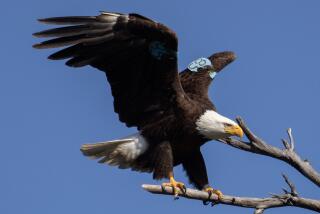Airport Plans Ruffle Feathers of Bird Fanciers : Wildlife: Bald eagles have established a nesting site nearby. Conservation groups want the new Denver facility to form a nature sanctuary.
- Share via
DENVER — A pair of bald eagles is on a collision course with Denver’s new $2.3-billion airport, and conservationists say the eagles and 330 other bird species that nest at Barr Lake State Park could be in danger.
Conservationists and wildlife officials want Denver International Airport to establish a buffer-zone nature sanctuary to prevent houses, offices and shops from sprouting up on its northwestern fringes near Barr Lake.
The airport, which opens in 1993, will not pay.
“We don’t feel we should,” said airport director Bill Smith. “We aren’t adding anything to the problems in the area, and we’re not increasing any problems that exist.”
Wildlife experts are surprised that the birds chose to nest just 18 miles from downtown Denver, and 3 miles northwest of the airport.
The eagles were the first on record to nest and to colonize on the Rocky Mountains’ eastern slopes in 1986. Previously, the eastern Colorado Front Range served only as a resting stop for eagles migrating south from Canada toward Mexico, New Mexico and Texas for the winter.
The birth of two eaglets last year drew numerous bird watchers. The eaglets later flew off, and wildlife officials are hopeful they will soon return to nest.
“There are only 10 bald eagle nesting sites in the whole state, and only one along the Front Range,” said Mike Carter, director of the Colorado Bird Observatory. “Don’t airport officials understand the principle of the straw that broke the camel’s back?”
Carter worried that the airport will destroy a unique opportunity for the endangered bald eagles to grab a foothold if it refuses to help out.
If the worst happens, the construction of the airport’s fringe developments would at least enable observers to document the destruction of a bird refuge, he said.
“There have been very few studies with 80 to 90 years of records, and this could be our first chance to document these changes,” Carter said. “I don’t see that as a benefit. This could destroy 100 years worth of resources.”
The airport already has concluded in a $35,000 study that, because of the airport’s noise regulations, incoming planes will not pose a threat. But construction near Barr Lake may drive the birds away, Carter said.
Barr Lake Park is made up of 2,000 acres of water and two narrow strips of land on each side that measure 700 acres. Wildlife records from the area have been kept since 1909, and 330 species are documented.
Warning signs prohibit entry to the eagles’ nesting area, and violators face a $20,000 fine and a year’s imprisonment. But outdoors enthusiasts can cross a narrow ridge and watch the birds through binoculars.
The Denver Audubon Society and Colorado Department of Natural Resources want the airport to put aside some of its discretionary funds for wildlife conservation to buy a 2,000-acre buffer zone around the lake, or buy development rights to prevent construction there.
The land’s cost has not been determined.
“All the buffer zone will do is keep developers away from the lake,” said its chairwoman, Polly Reetz. “In addition to the eagles, we have a lot of animals that move in and out, and raptors that hunt in fields adjacent to the park.”
Carter, of the Colorado Bird Observatory, would prefer a wildlife sanctuary on the airport grounds, a 2,000-foot-wide zone stretching from the airport to the nearby Rocky Mountain Arsenal, which already serves as a wildlife refuge.
Denver planners are negotiating with the Army, which owns the arsenal, to move fences and allow bike trails in the area to take advantage of arsenal wildlife, which include antelope, deer and coyotes.
The airport is being constructed to replace Denver’s Stapleton International, one of the nation’s busiest. It will occupy 50 square miles, and its main terminal will be heavily landscaped with greenery to promote the image of an oasis on the plains. Indoor waterfalls and fountains also are planned.
Carter said that without action, development will occur around the lake because of plans to complete a beltway around Denver. But he thinks the state and conservation groups should share with the airport the cost of protecting the birds and other wildlife.
Park spokeswoman Carol Leasure said farmers and landowners should not be penalized if airport-fringe developments are deferred.
“We want to see that they’re fairly compensated too,” she said.
More to Read
Sign up for Essential California
The most important California stories and recommendations in your inbox every morning.
You may occasionally receive promotional content from the Los Angeles Times.










